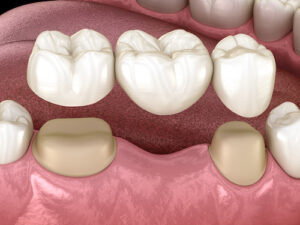Dental Bridges

Whether a tooth has fallen out or had to be extracted because of severe decay or structural damage, dental bridges are a common dental restoration used to replace missing teeth. Exactly as its name implies, a dental bridge’s structure spans the space left by a missing tooth. The teeth on either side of the gap serve as anchors, and an artificial tooth fills the space in the center. Dental bridges have a natural appearance after being inserted.
Types of Dental Bridges
Traditional Dental Bridge
The most typical kind of dental bridge is a classic one, and you may even be familiar with it. One dental crown is attached to each of the two teeth on each side of the gap, and a false tooth or teeth fill in the space. In this way, the false tooth “bridges” the gap while the dental crowns serve as anchor points. Traditional bridges are strong, which is one of their key advantages. The two adjacent teeth must be modified, which is one of the disadvantages.
Cantilever Dental Bridge
Cantilever dental bridges are structurally different from conventional dental bridges in that they only use one anchor tooth. They aren’t as commonly utilized as other bridge kinds, and they typically can only be positioned at the front of the mouth. Because they might put an undue amount of stress on a single tooth, cantilever bridges are not recommended for the rear of the mouth. Time and money may be saved by carefully placing a cantilever bridge. However, there are only a few situations in which this kind of bridge may be erected securely.
Maryland Bonded Bridge
Similar in design to a conventional dental bridge, a Maryland bonded bridge employs a metal or porcelain framework as the anchors rather than dental crowns. This framework doesn’t require the surrounding teeth to be altered; it is simply attached to the rear. In essence, Maryland bonded bridges offer a conservative and less expensive substitute for conventional bridges. Although metal frameworks can stain teeth, their strength is dependent on how strong the adhesive is.
Implant-Supported Bridge
Dental bridges that are supported by dental implants have the same basic design as conventional bridges but are fixed in place differently. As a result, implant-supported bridges may fill huge spaces left by several missing teeth without the need for nearby teeth. Dental implants are renowned for their power, toughness, and capacity to reestablish normal function. The placement process and recuperation time for this kind of dental bridge are more painful.
Benefits of Dental Bridges
BRING BACK YOUR SMILE
A beautiful and healthy smile is something you can’t put a price on. Following dental bridge operations, many patients report feeling more self-assured. Have you ever felt embarrassed or attempted to hide your grin in a group photo? By fixing your smile, dental bridges can enhance your quality of life.
IMPROVE CHEWING
You could find it challenging or even painful to consume your favourite meals after losing a tooth. Teeth next to the open gap may move toward it, resulting in pain. Additionally, food debris can amass in the vacant tooth socket and harm your gums.
IMPROVE SPEAKING
You can have trouble pronouncing some words or talk with a lisp if you’ve lost many teeth. You must treat the tooth loss that harmed your speech in the first place if you want to resolve these problems. Your ability to form words in your mouth depends critically on your teeth.
MAINTAIN YOUR FACE’S NATURAL SHAPE
Did you know that when a tooth is lost, your jawbone begins to deteriorate? Your jawbone’s bone cells are stimulated by your tooth roots. Your jawbone begins to degenerate in the absence of this stimulation. The form of your face might be impacted by severe jawbone degradation, which can cause further tooth loss and facial collapse.
